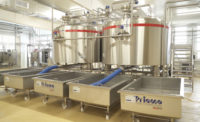Proactively responding to the growing concerns about water quality needs to become a priority for every cheese facility in America.
By Mike Jakob and Madhavi Batchu
Increased public concern regarding water quality has resulted in tighter restrictions on the effluent streams that can be legally released to surface waters. This is a growing trend in most areas of the United States but is more pronounced in areas with recognized deterioration in natural water bodies such as bays, lakes and streams. The more stringent restrictions are focused on biological oxygen demand (BOD) levels as well as phosphorus and nitrogen levels. (Phosphorus and nitrogen have been identified as powerful nutrients that impact aquatic environments negatively, even in small concentrations.)
As you may know, the cheese-making process generates a by-product known as “whey” that is naturally high in suspended organic solids and a potential contributor to elevated BOD levels. In addition, whey permeate -- the liquid that remains after the removal of whey solids -- is naturally high in nitrogen content. Phosphorus enters into a cheese-making facility’s waste stream as a result of phosphorus-based cleaners used in process-cleaning activities. If left untreated, this combination can, in fact, be a notable source of water degradation. Fortunately, most North American cheese facilities have wastewater treatment protocols that help to mitigate the impacts of these pollutants on the environment.
However, as the bar is raised, the wastewater treatment systems that currently exist also have reached the limit of their capabilities. The following example of the challenges recently faced by a Pacific Northwestern cheese producing company provides an excellent case in point.
Almost impossible effluent limits written into law
New laws affecting a major Northwestern river basin threatened to cripple a major area cheese producer with BOD limits below 3 mg/L, total nitrogen limits below 1 mg/L and total phosphorus limits below 0.07 mg/L -- all exceptionally low levels and levels that are difficult to achieve with most in-place wastewater treatment technologies.
This cheese producing facility had a complete wastewater treatment plant, which it had used successfully for years. However, the impending enforcement of new, much more stringent effluent requirements and a need to increase production volumes dictated a reevaluation of treatment options.
Company officials evaluated the various technologies available to the industry and ultimately decided that their best option was to install the enhanced nutrient removal (ENR) technologies of the Parkson Corp., a well-known leader in industrial wastewater innovation.
The specific technology that was recommended by the Parkson team was a dual upflow sand filtration system with a proven record of achieving extremely low levels of effluent nutrients.
This proprietary Parkson system, which is referred to as the DynaSand D2 Advanced Filtration System, is based on a modular approach that encompasses two specialized cleaning units. These DynaSand units can best be described as continuously self-cleaning filters installed in series. In this arrangement, the first filter, referred to as the first stage filter, employs larger-sized sand granules to maximize solids removal capabilities. The second filter unit, utilizing smaller-sized sand granules, acts as a polishing filter. Following the DynaSand units, the third component of the DynaSand D2 system, a Lamella Gravity Settler, treats the small amount of reject from both filter stages, which amounts to less than 0.5% of the feed flow to the filters.
Technology rescues this cheese plant from impending violations
After several years of operation, the DynaSand D2 system has proven to be the perfect answer for this specific cheese-maker’s effluent challenges. The actual results are impressive and well below legal limits. Total phosphorus has consistently been below 0.07 mg/L, often substantially lower. Total nitrogen has remained below 1 mg/L. BOD has stayed below 3 mg/L and as a bonus, turbidity has settled into a range of 0.05 to 0.10 NTU. These are numbers that any type of facility would be proud to share, and significantly, all are well within legal limits.
Now, the owner of this cheese facility can not only be extremely proud of the cheese produced in the plant, but also quite confident of the eco-friendly effluent that is released into the environment. Given this positive outcome from a potentially troubling situation, it is easy to see that the decision to add the DynaSand D2 was not only a thoroughly responsible move by the company, but one that will hold it in good stead with the local community and its cheese consuming customers for many years into the future.
Of course, every cheese plant is different
Even though there are many processes common to all cheese plants, their approach to wastewater treatment can be as individual as a fingerprint. Today, most plants in North America have some form of wastewater treatment, although the level of sophistication can range from earthen-lined basins, which depend on haulage and land application, to state-of-the-art plants that incorporate the full scope of a municipal wastewater treatment facility. Wastewater treatment is particularly important to the cheese industry because the cheese making process is by its very nature water intensive and thus, wastewater intensive. In fact, the untreated effluent from the typical cheese plant is five to 10 times more contaminated with nutrients, with many times the BOD, than a similar quantity of ordinary sewage. Plus, with flows in the range of 500,000 mgd, many cheese plants produce more effluent than some small cities.
To meet even the most relaxed standards, every cheese plant needs a technology to separate whey solids from the whey permeate. This is best accomplished with rotary-screen technologies designed for heavy-duty solids removal. (Some plants have explored recycling methods that further dewater the whey and turns it into an economic by-product, and many simply land apply the dewatered whey solids.)
Typically, the remaining whey permeate is processed through conventional biological treatment that depends on aeration of the permeate to support digestion of contaminants. Finally, clarification in quiescent basins brings the process to the stage of final filtration.
Responding proactively to the growing concerns about water quality needs to become a priority for every cheese facility in America.
Even if the effluent limits have not already been restricted in your locale, it is unwise to become too complacent regarding impending developments relative to water regulations. Without question, interest is very much on the rise relative to improving and protecting water quality all across America. This means that consideration of enhanced wastewater treatment options should be ongoing so that preparations are in place well before production levels or public images are threatened by ever more stringent effluent requirements.
Today, the wholesome image of the cheese industry is on a par matched by few other industries. We must all work together to keep it that way well into the future. Attention to the industry’s impact on water quality is one important way to achieve this goal.
How The DynaSand technology works
The DynaSand is a proprietary technology that maximizes the advantages of Continuous Contact Filtration (CCF). In the CCF process, coagulation, flocculation and separation take place within the filter bed and produce a very high quality filtrate. Exceptionally effective separation within a DynaSand filter is achieved at a much smaller floc size, which minimizes chemical usage by up to 30%.
Influent feed is introduced at the top of the filter and flows downward through an annular section between the influent feed pipe and airlift housing. The feed is introduced into the bottom of the sand bed through a series of feed radials that are open at the bottom. As the influent flows upward through the downward moving sand bed, organic and inorganic impurities are captured by the sand. The clean, polished filtrate continues to move upward and exits at the top of the filter over the filtrate weir and out through the effluent pipe.
The DynaSand D2 system employees a deep bed DynaSand filter installed in series with a standard bed DynaSand filter, followed by a Lamella Gravity Settler.
About:
Mike Jakob has more than 30 years experience in the water and wastewater industry and holds degrees in chemistry and environmental engineering.
Madhavi Batchu is a leading applications engineer, specializing in industrial water and wastewater.
Jakob and Batchu are both employed by Parkson Corp., a world leader in water and wastewater, with extensive experience in the dairy and cheese industry.
Get our new eMagazine delivered to your inbox every month.
Stay in the know on the latest dairy industry trends.
SUBSCRIBE TODAYCopyright ©2024. All Rights Reserved BNP Media.
Design, CMS, Hosting & Web Development :: ePublishing


